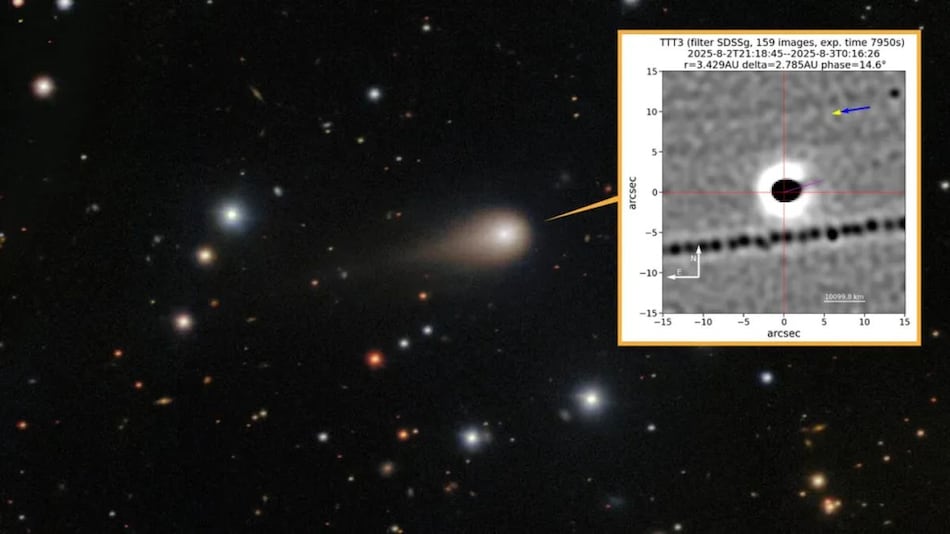- Home
- Science
- Science News
- New Images of Interstellar Object 3I/ATLAS Show a Giant Jet Shooting Toward the Sun
New Images of Interstellar Object 3I/ATLAS Show a Giant Jet Shooting Toward the Sun
New images reveal interstellar comet 3I/ATLAS blasting a massive jet toward the Sun.

Photo Credit: International Gemini Observatory/NOIRLab/NSF/AURA
Interstellar comet 3I/ATLAS captured ejecting a powerful jet of gas and dust sunward
Newly captured images of the interstellar comet 3I/ATLAS show a striking jet of gas and dust shooting toward the Sun, confirming the object's natural behaviour. Detected in late June and confirmed by NASA in July, 3I/ATLAS originates from a distant star system and is only the third interstellar object ever seen. Estimated to be between 5 and 11 kilometres wide, it is the largest such visitor yet discovered and possibly the oldest, dating back billions of years before the Sun's formation.
New Telescope Images Capture Interstellar Comet 3I/ATLAS Blasting a 10,000-Kilometer Jet Toward the Sun
As per a Live Science report, the latest images were captured on August 2 by the two-metre Twin Telescope at Spain's Teide Observatory in the Canary Islands. The composite picture, made of 159 individual exposures, displays a dark nucleus surrounded by a bright white coma and spewed material cloud up toward the sun in the appearance of a bright fan. Such jets are typical when sunlight heats up one side of a comet more than other parts, said Miquel Serra-Ricart, an astrophysicist at the Teide Observatory. This is causing gases to shoot out into space like geysers.
Comets release jets when frozen material turns into gas under solar heat, with weaker spots bursting and plumes of gas and dust. The jet's fan-shaped appearance is a common pattern.
Comets have a unique appearance with a sunward jet and tail pointing away from the Sun, with a newly detected jet from 3I/ATLAS likely composed of carbon dioxide and dust.
3I/ATLAS makes its closest point to the Sun as it skirts Mars on 29 October. seeing how the comet's nucleus, its tail, and the jet activity would evolve after the mid-November solar encounter predicted by astronomers.
Get your daily dose of tech news, reviews, and insights, in under 80 characters on Gadgets 360 Turbo. Connect with fellow tech lovers on our Forum. Follow us on X, Facebook, WhatsApp, Threads and Google News for instant updates. Catch all the action on our YouTube channel.
- Samsung Galaxy Unpacked 2025
- ChatGPT
- Redmi Note 14 Pro+
- iPhone 16
- Apple Vision Pro
- Oneplus 12
- OnePlus Nord CE 3 Lite 5G
- iPhone 13
- Xiaomi 14 Pro
- Oppo Find N3
- Tecno Spark Go (2023)
- Realme V30
- Best Phones Under 25000
- Samsung Galaxy S24 Series
- Cryptocurrency
- iQoo 12
- Samsung Galaxy S24 Ultra
- Giottus
- Samsung Galaxy Z Flip 5
- Apple 'Scary Fast'
- Housefull 5
- GoPro Hero 12 Black Review
- Invincible Season 2
- JioGlass
- HD Ready TV
- Laptop Under 50000
- Smartwatch Under 10000
- Latest Mobile Phones
- Compare Phones
- Lava Play Max
- Poco C85 5G
- Honor Magic 8 Lite
- Jolla Phone
- Realme P4x 5G
- OnePlus Ace 6T
- Nubia Flip 3
- Nubia Fold
- Asus ProArt P16
- MacBook Pro 14-inch (M5, 2025)
- OnePlus Pad Go 2
- Poco Pad M1
- Just Corseca Skywatch Pro
- Honor Watch X5
- Acerpure Nitro Z Series 100-inch QLED TV
- Samsung 43 Inch LED Ultra HD (4K) Smart TV (UA43UE81AFULXL)
- Asus ROG Ally
- Nintendo Switch Lite
- Haier 1.6 Ton 5 Star Inverter Split AC (HSU19G-MZAID5BN-INV)
- Haier 1.6 Ton 5 Star Inverter Split AC (HSU19G-MZAIM5BN-INV)












